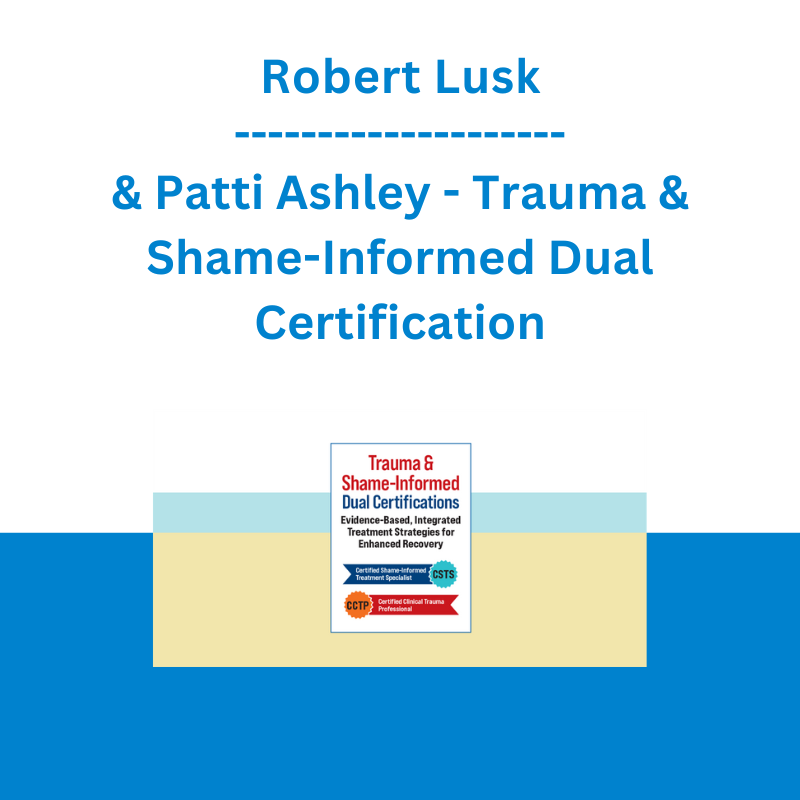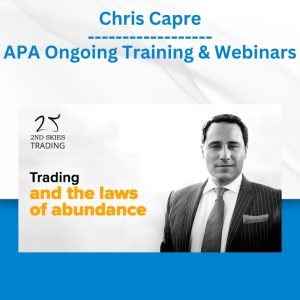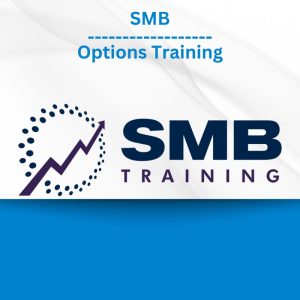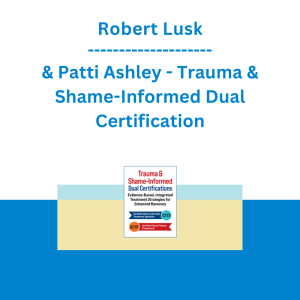*** Proof of Product ***
Exploring the Essential Features of “Robert Lusk & Patti Ashley – Trauma & Shame-Informed Dual Certification: Evidence-Based, Integrated Treatment Strategies for Enhanced Recovery”
One step ahead, two steps back – the treatment pattern endlessly frustrates both you and your client, but it doesn’t have to be hard to get your clients on step from trauma and shame spirals.
When you register for this unique TWO certification(s) course that combines trauma and shame-informed treatment training and must-have interventions…
You’ll gain shame-informed strategies to get your clients unstuck from avoidance so you can rapidly treat their trauma symptoms and help them overcome fears, build resiliency and achieve self-acceptance.
You’ll get…
- Turnkey assessment tools, somatic approaches and more strategies that will enhance your work to quickly help your clients end avoidance, cultivate secure attachment and manage shame-related symptoms from preeminent shame expert, Patti Ashley, Ph.D., LPC.
- Outside-the-box techniques to five critical domains in trauma treatment, ready-to-use solutions beyond DSM-5® models that integrate neurobiology, physiology, the 3 stages of trauma recovery and more from Robert Lusk, Ph.D., a trauma expert for over 30 years.
Get your clients on track — and stay on track — to an evidence-based roadmap with two experts who’ve helped thousands of clinicians like you achieve transformational clinical results.
Change your practice and change your life…
We’ve combined two preeminent experts that have found clinical solutions to some of your most pressing questions:
- How can I cut through the clutter of all the possible factors contributing to trauma and get a clear picture of the issues to address in therapy?
- How do I make the best use of the growing body of neuroscience research?
- How can I tailor my approach to meet the unique needs of each survivor?
- If shame-informed treatments were not part of our university or supervised training, then how do we know what’s effective?
- How will you move your clients forward when they’ve spent a lifetime viewing themselves as wrong, unlovable, and unworthy of getting better?
Best of all, these video modules and handouts are yours to access at your own pace and keep forever. So, get the training you need now… and walk away with a comprehensive trauma and shame-informed guide you’ll use throughout your career.
For more detailed information: Click here for course objectives and outline, and Click here for Credit hours breakdown.
Session 1: Trauma Treatment Certification Training
By Robert Lusk, Ph.D. | Click here for information about Robert Lusk
Robert Lusk, Ph.D.’s treatment strategy is an integration of neuroscience, physiology, the three stages of trauma recovery, smaller ingredients taken from larger evidence-based models, and customizable treatment strategies that address the unique needs of trauma survivors and their families.
This trauma-intensive session presents Dr. Lusk’s integrated and customizable approach to trauma treatment in a manner that is easy-to-follow and readily adaptable to a variety of scenarios. You’ll discover how to use this integrated model as a foundation upon which you can then tailor and apply treatment approaches with which you are already familiar, but until now seemed rigid and inflexible.
You’ll be able to move beyond the standard script often given for when and how to apply various strategies, allowing you to focus much more intently on where the trouble spots are in each survivor’s life and what actions to take to resolve them. You’ll get a road map that will help you to guide each survivor through all the stages in the trauma recovery process.
Trauma Treatment Certification Training Outline
Trauma Impact: Summary of the Research
- Definitions & concepts
- Short term and long-term effects (the ACE study)
- The “good” and “bad” news about trauma exposure
- Limitations of the research
Assessment and Diagnosis of Trauma
- Assessment of trauma in children, adolescents and adults
- Trauma- & Stressor-Related Disorders in the DSM-5®
- What’s still missing from the DSM-5®?
- Common pitfalls in diagnosis
- My “favorite” diagnosis & why to use it frequently
Address Trauma’s Impact on Neurobiology
- Major areas of impact
- The 3-part brain (or upstairs/downstairs brain)
- Neurologically-related issues in trauma survivors
- ”Arrested Development”
- ”Hair Trigger” threat response
- Cognitive, academic, & work-related problems
- Relationship problems
- The arousal continuum
- Dissociation
Evidence-based Treatments vs. the “Real World”
- What does “evidence-based” mean in trauma treatment?
- Components of evidence-based treatments
- The evidence-based components approach
Points of Intervention in Trauma Treatment
- Main entry points: immediate support vs. trauma treatment
- Psychological first aid
- Stages of trauma-focused treatment
- What can you do if your client isn’t emotionally or physically safe?
- Trauma-Focused Cognitive-Behavioral Therapy: The “Gold Standard”
- Case Examples:
- ”Amanda”: 7-year-old girl with sexual abuse and complex family issues
- ”Phil”: mid-30s man whose son died while in his care
Address Critical Domains in Trauma Treatment
- The Physiology Domain
-
- Sleep
- Nutrition and hydration
- Sensory needs and interventions
- Medications, supplements, & nontraditional interventions
- Physical activity/exercise
- ”Amanda” and “Phil” and the physiology domain
- The Relationship Domain
-
- The Attachment, Regulation, & Competency (ARC) model (for youth)
- Teaching caregiver emotional control (for caregivers of youth)
- Build attunement (for caregivers of youth)
- Positive discipline (for caregivers of youth)
- Build the therapeutic alliance
- Build a support network
- Implement routines & rituals
- ”Amanda” and the relationship/attachment domain
- ”Phil” and the relationship domain
- The Emotional Regulation Domain
-
- Feelings identification and expression
- Use SUDs scales
- Grounding & self-soothing techniques
- The “Comfort Kit”
- Add attunement!
- Apply Bruce Perry’s Neurosequential Model of Therapeutics™
-
-
- NMT assessments
- NMT: Interventions by developing age
-
-
- ”Amanda” and “Phil” and the emotional regulation domain
- The Cognitive Domain
-
- Teach and practice problem-solving
- Teach and practice mindfulness
- Address distorted cognitions: Most common targets of cognitive processing
- Cognitive processing: how to modify problematic thoughts
- Use the Franklin Method
- ”Amanda” and “Phil” and the Cognitive Domain
- The Identity Domain
-
- Focus on identity and sense of self
- Build on existing strengths
- The Life Book approach
- Exercises to improve identity
- ”Amanda” and “Phil” and the identity domain
For more detailed information: Click here for course objectives and outline, and Click here for Credit hours breakdown.
Session 2
Shame-Informed Treatment Certification Training
Patti Ashley, Ph.D., LPC
Shame can push your clients to hide their innermost feelings, put them into a freeze state where they feel trapped and powerless, or cause them to lash out at you in-session as they mask their shame with anger and blame.
This intensive shame-informed certification training will give you the skills and tools you need to end the tyrannical hold of shame and empower your clients to develop the acceptance of themselves, others and reality necessary for the effective treatment of shame-prone clients with trauma, stress, anxiety, eating disorders, substance use, and anger issues.
Watch and get the training you need to:
- End shame avoidance that stalls therapy
- Reduce judgmental thoughts and reactivity
- Reclaim the body from shame
- Overcome fears about failure, inadequacy and rejection that get clients stuck
- Build shame resiliency with interventions based on empathy, forgiveness and compassion
Shame-Informed Treatment Certification Training Outline
Shame, Attachment and Social-Emotional Development
- The difference between guilt, shame and core shame
- Shame and attachment
- Ruptured interpersonal bridges
- The evolution of social-emotional development
- Why self-compassion is so hard to access
The Neurophysiology of Shame: Polyvagal Theory, Shame and the Shutdown Response
- Shame and the Vagus Nerve
- Neuroception, shame and felt safety
- Core shame and implicit memory
- Three common responses to shame
- How addressing shame expedites treatment
Recognizing Shame: Assessment Tools
- Why shame goes undetected by clinicians
- Multicultural perspectives
- Perfectionism, rage, blame and other defenses against shame
- Reading the body – non-verbal signs of shame
- Interview questions for assessing shame in relationships and current patterns
- Self-assessment: identify your own shame
How to Create a Safe and Empathetic Therapeutic Environment
- Mirror neurons and relational presence
- Attunement as the key to therapeutic change
- Large Empathy and being vulnerable
- Avoid stigmatizing language in therapy
- Co-regulating safety and equal power in the therapeutic relationship
Re-Write the Story of Shame into “I Am Enough”: Clinical Strategies to Cultivate Secure Attachment and Self-Compassion
- Somatic approaches to cultivate secure attachment
- Self-compassion and gratitude exercises
- The four therapeutic “R”s: Recognize, Respect, Regulate and Re-Story
- Four “C” shovels to calm nervous system and self-regulate shame response
- Exercises to strengthen connections
- Creative arts, music and poetry – increase neuroplasticity
- Playfulness, humor and being in nature can rewire the brain
- Mindfulness and meditations for non-judgmental awareness of shame
- Narratives and visualizations to re-write clients stories to safety and being enough
- Research, limitations and potential risks
Trauma
- Somatic interventions
- Strategies to survive without guilt
- Exercises to rediscover self-worth
Stress and Anxiety
- Mediate the paralysis of perfection with self-acceptance
- Social anxiety as shame & self-doubt
- Mindfulness-based, non-anxious self-consciousness
Eating Disorders
- How shame pushes clients into binge eating
- Choice Awareness Training for moderation & presence
- Self-acceptance strategies for emotional eating
Substance Abuse and Addiction
- Addressing the shame of relapse
- Self-assertive trigger avoidance
- Choice awareness techniques for habit modification
- Build craving/impulse control skill power
Depression, Self-Harm & Suicidality
- Recognize how internalized shame can deepen depression
- Developing healthy coping strategies for uncomfortable feelings
- Demystifying shame responses and returning them to their origin
For more detailed information: Click here for course objectives and outline, and Click here for Credit hours breakdown.
Please see the full list of alternative group-buy courses available here: https://lunacourse.com/shop/










 Fred Haug - Virtual Wholesaling Simplified
Fred Haug - Virtual Wholesaling Simplified  Crypto Dan - The Crypto Investing Blueprint To Financial Freedom By 2025
Crypto Dan - The Crypto Investing Blueprint To Financial Freedom By 2025  Matthew Kratter - Trader University
Matthew Kratter - Trader University  Simpler Trading - Bruce Marshall - The Options Defense Course
Simpler Trading - Bruce Marshall - The Options Defense Course  Trade Like Mike - The TLM Playbook 2022
Trade Like Mike - The TLM Playbook 2022  Money Miracle - George Angell - Use Other Peoples Money To Make You Rich
Money Miracle - George Angell - Use Other Peoples Money To Make You Rich  Matan Feldman - The 13-Week Cash Flow Modeling - Wall Street Prep
Matan Feldman - The 13-Week Cash Flow Modeling - Wall Street Prep  Team NFT Money - Ultimate NFT Playbook
Team NFT Money - Ultimate NFT Playbook  George Fontanills & Tom Gentile - Optionetics 6 DVD Series Home Study Course (Digital Download)
George Fontanills & Tom Gentile - Optionetics 6 DVD Series Home Study Course (Digital Download)  Oliver Velez - Essential Strategy Of Trade For Life
Oliver Velez - Essential Strategy Of Trade For Life  Modern Web Design Demystified - Andy Pratt & Jesse Arnold
Modern Web Design Demystified - Andy Pratt & Jesse Arnold  Kelsey Formost – Copy Class
Kelsey Formost – Copy Class  SMB - Options Training
SMB - Options Training  Robert Lusk & Patti Ashley - Trauma & Shame-Informed Dual Certification: Evidence-Based, Integrated Treatment Strategies for Enhanced Recovery
Robert Lusk & Patti Ashley - Trauma & Shame-Informed Dual Certification: Evidence-Based, Integrated Treatment Strategies for Enhanced Recovery